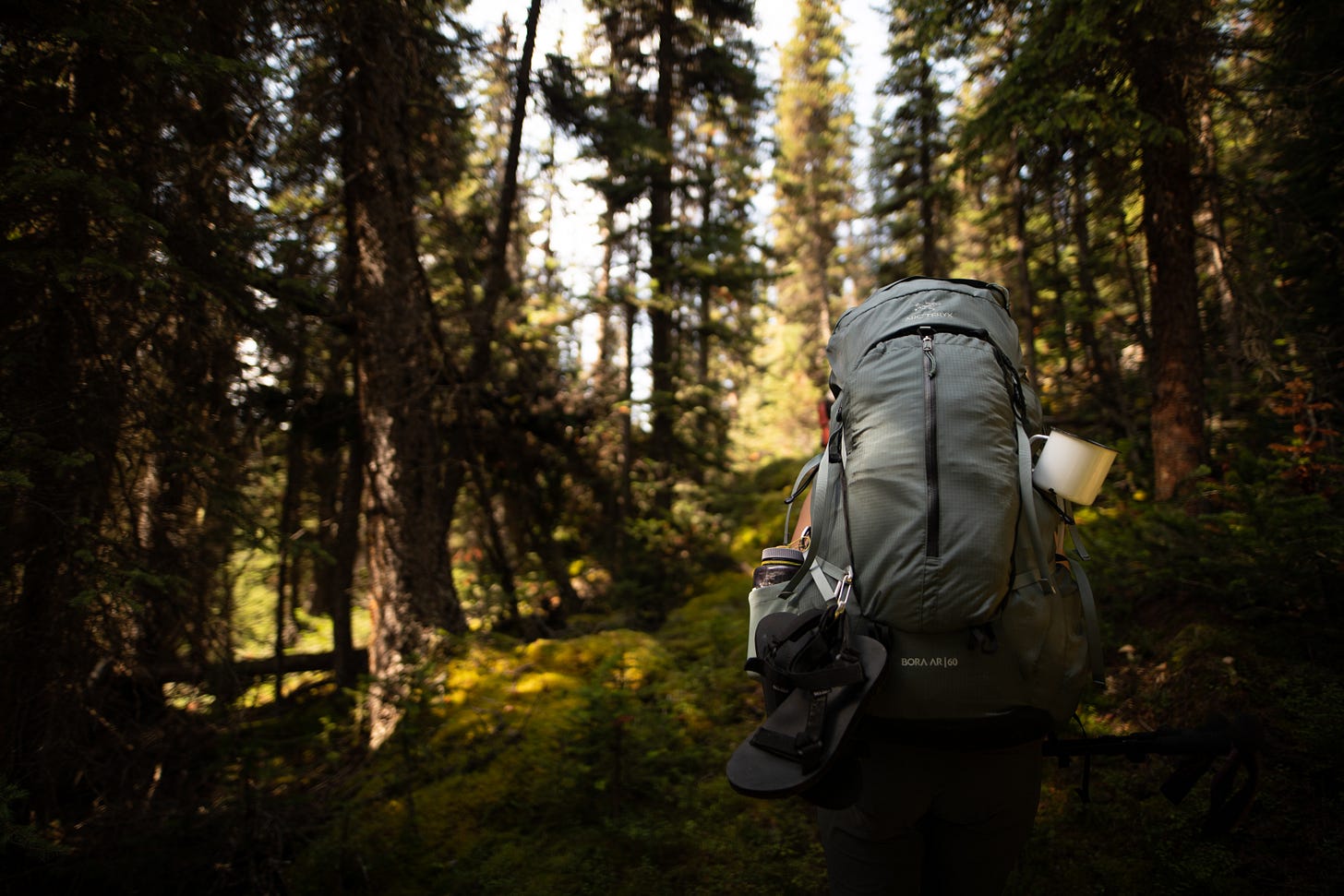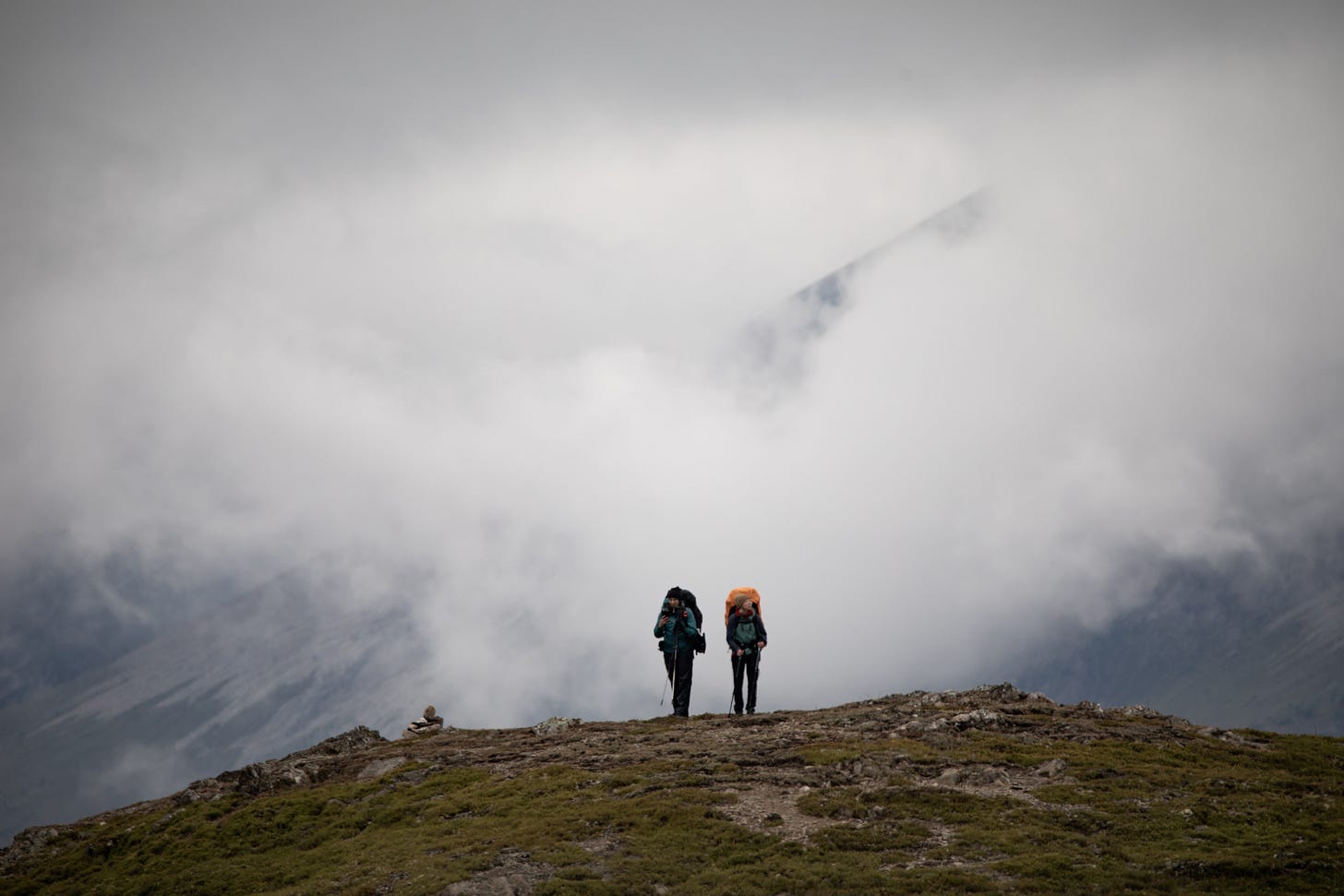Reinventing Yourself in the Rockies
Meghan J. Ward talks about Wildflowers, a new documentary film exploring the remarkable story of Mary Schäffer Warren
Go Outside subscribers receive advice, stories, trip reports, interviews, reflections, opinions, and outdoorsy goodness in their inboxes. If you enjoy and value our work, consider becoming a paid subscriber. Contributions from readers like you make this newsletter possible.
Meghan on the Maligne River Valley Trail. Photo by Nat Gillis
This week we caught up with Banff-based outdoor, travel and adventure writer Meghan J. Ward, who is working on an exciting new project.
Her film Wildflowers blends backcountry adventure in the Canadian Rockies with history, to tell the story of two female mountain writers living a century apart. And it’s a woman-powered documentary, made by a team of talented female filmmakers, writers and photographers. Watch the film’s teaser here.
We chatted with Meghan about the film, the remarkable story of Mary Schäffer Warren, scoring a coveted backcountry reservation for the film, and her favourite hiking trails in Banff National Park. Read on:
Mary Schaffer Warren with horse. Image courtesy Whyte Museum of the Canadian Rockies (v527-ps-1-151)
Q: Tell us about Wildflowers, the film you're working on. What's it about?
A: Wildflowers is a woman-powered documentary film about one of Canada's most overlooked trailblazers. The film blends backcountry adventure with a historical deep-dive to explore the themes that bond two writers living a century apart. Our first character is Mary Schäffer Warren (1861-1939), a Pennsylvania-born Quaker woman who reinvented herself in her middle age as an explorer, writer, photographer and artist in the Canadian Rockies. The second is me, a mountain writer based in Banff, Alberta, also an avid adventurer and Fellow of the Royal Canadian Geographical Society. I am a co-producer on the film with Trixie Pacis, who is also the film’s director.
When did you first hear about Mary Schäffer Warren, and what led you to look deeper into her story?
I first moved to the Canadian Rockies in 2005 and it didn’t take long before her name popped up as a legendary force in Rockies history. She is best known for her 1908 journey to Maligne Lake, also known as Chaba Imne in Îyârhe Nakoda (she and her adventure companion Mollie Adams are known as the first non-Indigenous women to explore the land northwest of present-day Lake Louise). She also wrote the still popular book, Old Indian Trails of the Canadian Rockies (1911), which has been republished as A Hunter of Peace.
Over the years, I have found my life as a Banff resident and writer weaving in and out with Mary’s story in rather incredible ways. A few years ago, I even moved in across the street from her historic home! So when Trixie came to me with this idea she had for a film (she, too, had been captivated by Mary’s story), it was only natural for me to leap on board and explore Mary’s life in greater detail.
For you, what's so compelling about Mary Schäffer Warren? What do you hope people gain from hearing her story?
Mary Schäffer Warren allowed herself to be many things in life (often simultaneously) and she wasn’t afraid to reinvent herself. She went through a fair amount of trauma and loss in her life, including the deaths of her parents and first husband within a year of each other when she was 43. This ultimately ignited her adventurous spirit when she dedicated herself to finishing her husband’s botanical work in the backcountry regions of the Canadian Rockies, which required her to hire a guide (Billy Warren) and embark on horsepacking expeditions for weeks on end. Later in life, she dedicated herself to community initiatives and nurturing the lives of young people in Banff. She was certainly opinionated but with that strength came gusto, and she left behind an impressive legacy.
What we hope people ultimately gain from her story is the inspiration to reinvent ourselves at any stage of life (I’ve just turned 40, so I have been leaning into this lesson a lot!), to establish a meaningful relationship with nature, to look more closely at the colonial history of the Canadian Rockies, and also examine what it means to have a wild spirit.
Meghan on horse during an expedition in the Skoki Valley. Photo by Trixie Pacis
Can you tell us a little more about the adventure into the Maligne River Valley you went on for this film?
From the beginning of the project, which dates back to 2020 when Trixie did the Adventure Filmmaker’s Workshop at Banff Centre, we knew we wanted to retrace part of Mary’s journey between Lake Louise and Maligne Lake. For various reasons, we chose the very final leg of that journey through the Maligne River Valley, which included swapping the hiking boots for canoes when we arrived at the shores of Maligne (Mary’s crew built a raft). But this journey is in highly-protected grizzly bear habitat in which only one permit is granted per campground each night. It’s also a part of the Great Divide Trail, so it is highly competitive. We had limitations in terms of dates because we were also working to align the schedules of a 4-person film team.
The morning that backcountry reservations opened in Jasper National Park, we had a crew of six people online, ready to help us secure the dates we needed, as well as the sequential campgrounds so that we could complete the trek between Poboktan Creek and Trapper Creek Campground. Fortunately, one person on our booking team got into the system early, so we had our shot at our preferred dates. The system froze at one point, which kept us all on our toes, but when we finally got it booked, we were elated. We knew at this point we could finally make the film we had envisioned.
Meghan Ward and Jane Marshall at Maligne Pass. Photo by Nat Gillis
What stage are you at now with the documentary? Is there a way for people to support the film?
The documentary is currently in the editing room as part of a multi-staged (and faceted) process that will eventually bring in the talents of other creatives such as a composer, animator, graphic artist, sound designer and colourist. We intend to have the film ready this summer to begin the process of submitting it first to the film festival circuit before broadening its reach.
People can support the film by following us at @wildflowers.film on Instagram, checking out our website, sharing our content, and taking the opportunity to see the film when it comes out! We are also open to receiving independent donations if anyone would like to support the film financially (please contact us to do so!).
When you're not working as a writer, editor, historian and now film co-producer, what outdoor adventures in Alberta do you enjoy? Any favourite trails?
Banff is an incredible base for adventure in Alberta year-round, but my favourite seasons are summer and fall. You’ll usually find me hiking, whether it’s with my kids or friends, both on one-day outings or multi-day backcountry trips. My favourite trails are those along the Icefields Parkway, such as Helen Lake, Bow Glacier Falls, and Caldron Lake, as well as various multi-day trails like the Skoki Region, Egypt Lakes, and some just over the border, like the Little Yoho Valley and the Rockwall. Often, my husband and I just look at the map of Banff National Park and check out the lesser-known corners, which always turns out to be an adventure!









Thanks for taking the time to talk about Wildflowers! For anyone looking for some great reads, we've created a resource library on our website that features the books we've leaned into in the creation of this film. https://www.wildflowersfilm.ca/news/our-resource-library
Love this style and the article itself!